Temperature Distribution Characteristics of Concrete during Fire Occurrence in a Tunnel
Abstract
:1. Introduction
2. Characteristics of Fire in a Tunnel
2.1. Material Characteristics of Concrete Exposed to High Temperature
2.2. Temperature Distribution Characteristics Due to Vehicle Fire in a Tunnel
3. Tunnel Fire Simulation
3.1. Modelling
3.2. Analysis of Fire by Combustion Material Type
3.3. Analysis of Vehicle Fire in a Tunnel
4. Fire Exposure Experiment on Reinforced-Concrete Member
4.1. RABT Fire Curve
4.2. Dimensions of the Specimen and Experimental Method
5. Experimental Results and Analysis
5.1. Analysis of Vehicle Fire in the Tunnel
5.2. Fire Exposure Experiment of Reinforced-Concrete Member
6. Conclusions
- (1)
- The results of the FDS tunnel fire analysis for each combustion material showed that diesel had a longer fire duration at the same fire intensity in comparison to the other tested fuels. As diesel is also the most commonly used fuel, it was selected as the fire source in the fire analysis that followed.
- (2)
- The results of the fire analysis showed that the peak temperature on the concrete surface was approximately 1380 °C and that at a depth of 60 mm, the temperature was approximately 405 °C. These values do not satisfy the maximum critical temperatures for concrete and reinforcement bars that have been suggested by the ITA. These maximum temperatures are 380 °C and 250 °C, respectively. When a fire corresponding to 27,000 L of diesel occurs, the desirable coating thickness of the tunnel structure is 80 mm, which is greater than 60 mm.
- (3)
- The analysis results for fire caused by dangerous-goods vehicles in the tunnel showed that at approximately 300 s after the beginning of the fire, the surface temperature of the concrete increased to approximately 1000 °C. This high temperature was maintained for approximately 1800 s. Therefore, on the basis of the empirical verification of the high-temperature exposure characteristics of concrete structures, the RABT fire curve was applied, in which the temperature rapidly increased to 1200 °C within 5 min. These results were similar to those of the analysis. Furthermore, since the maximum temperatures for concrete and reinforcement bars are specified as 380 °C and 250 °C, respectively, by the ITA, it is desirable to determine the fire damage that has been caused to the specimen on the basis of the suggested standards when an RABT fire curve with a significant temperature rise is used.
- (4)
- The results of the RABT fire experiment showed serious spalling to a depth of 60 mm, or, in other words, the point at which reinforcement bars are located in concrete. The temperature inside the concrete rose rapidly depending on the spalling. The temperature measured at a depth of approximately 60 mm, where spalling occurred, was similar to that inside the furnace. The temperature at a depth of 80 mm was approximately 420 °C during the rising period and 540 °C during the descending period.
- (5)
- On the basis of the results of the RABT fire curve experiments, 80 mm is the desirable minimum coating thickness of a tunnel concrete member in order to secure the safety of such structures during serious fires.
Author Contributions
Funding
Conflicts of Interest
References
- Shim, J.-W.; Kim, N.-Y.; Rhee, J.-Y.; Jang, T.-S. Development of Fire Protection Design and Blast Resistance Methods of Tunnels and Bridges caused by Fire and Explosions of Vehicles. Korea Expressway Corp. Res. Inst. Rep. 2018, 1–14. [Google Scholar]
- Kim, H.-Y.; Kim, H.-J.; Cho, K.-S.; Lee, J.-S.; Kwon, K.-H. An Experimental Study on Thermal Damage and Spalling of Concrete Lining in Tunnel Fire. J. Korean Inst. Fire Sci. Eng. 2009, 23, 110–120. [Google Scholar]
- Maevski, I.Y. NCHRP Synthesis 415: Design Fires in Road Tunnels—A Synthesis of Highway Practice; Transportation Research Board: Washington, DC, USA, 2011. [Google Scholar]
- Lönnermark, A. On the Characteristics of Fires in Tunnels. Ph.D. Thesis, Department of Fire Safety Engineering, Institute of Technology, Lund University, Lund, Sweden, 2005. [Google Scholar]
- Shim, J.-W.; Kim, N.-Y.; You, B.-O.; Park, Y.-H. Fire Cases and Damage Evaluations in Fire of Tunnels and Underground Structures. Mag. Korea Conc. Inst. 2011, 23, 39–43. [Google Scholar]
- Jin, K. A Study on the Improvements of Risk Index through the Analysis of Large Road Tunnel Fire. Master’s Thesis, Yonsei University, Seoul, Korea, 2019. [Google Scholar]
- Ministry of Land, Infrastructure, and Transport. Assessment of Fire Risk of Bridges on National Routes and Development of Response System. In Land, Infrastructure and Transport R&D Report; Ministry of Land, Infrastructure and Transport: Sejong, Korea, 2017. [Google Scholar]
- Won, J.-P.; Park, K.-H.; Park, C.-K. Performance of Hybrid Fiber Reinforced Concrete at Evaluated High Temperature. J. Korea Conc. Inst. 2008, 20, 325–333. [Google Scholar]
- WG 6 of the Road Tunnels Committee. Fire and Smoke Control in Road Tunnels. Available online: https://www.piarc.org/en/order-library/3854-en-Fire%20and%20Smoke%20Control%20in%20Road%20Tunnels.htm (accessed on 09 October 2019).
- McGrattan, K.; Hostikka, S.; McSermott, R.; Floyd, J.; Weinchenk, C.; Overholt, K. Fire Dynamics Simulator Technical Reference Guide. Available online: https://www.thunderheadeng.com/wp-content/uploads/2013/08/FDS_Technical_Reference_Guide.pdf (accessed on 09 October 2019).
- Experts for Specialised Construction and Concrete Systems (EFNARC). Specification and Guidelines for Testing of Passive Fire Protection for Concrete Tunnels Linings. Available online: http://www.efnarc.org/pdf/Testing%20fire%20protection%20systems%20for%20tunnels.pdf (accessed on 09 October 2019).
- Working Group No. 6. Maintenance and Repair Guidelines for Structural Fire Resistance for Road Tunnels. Available online: https://about.ita-aites.org/publications/wg-publications/100-guidelines-for-structural-fire-resistance-for-road-tunnels (accessed on 09 October 2019).


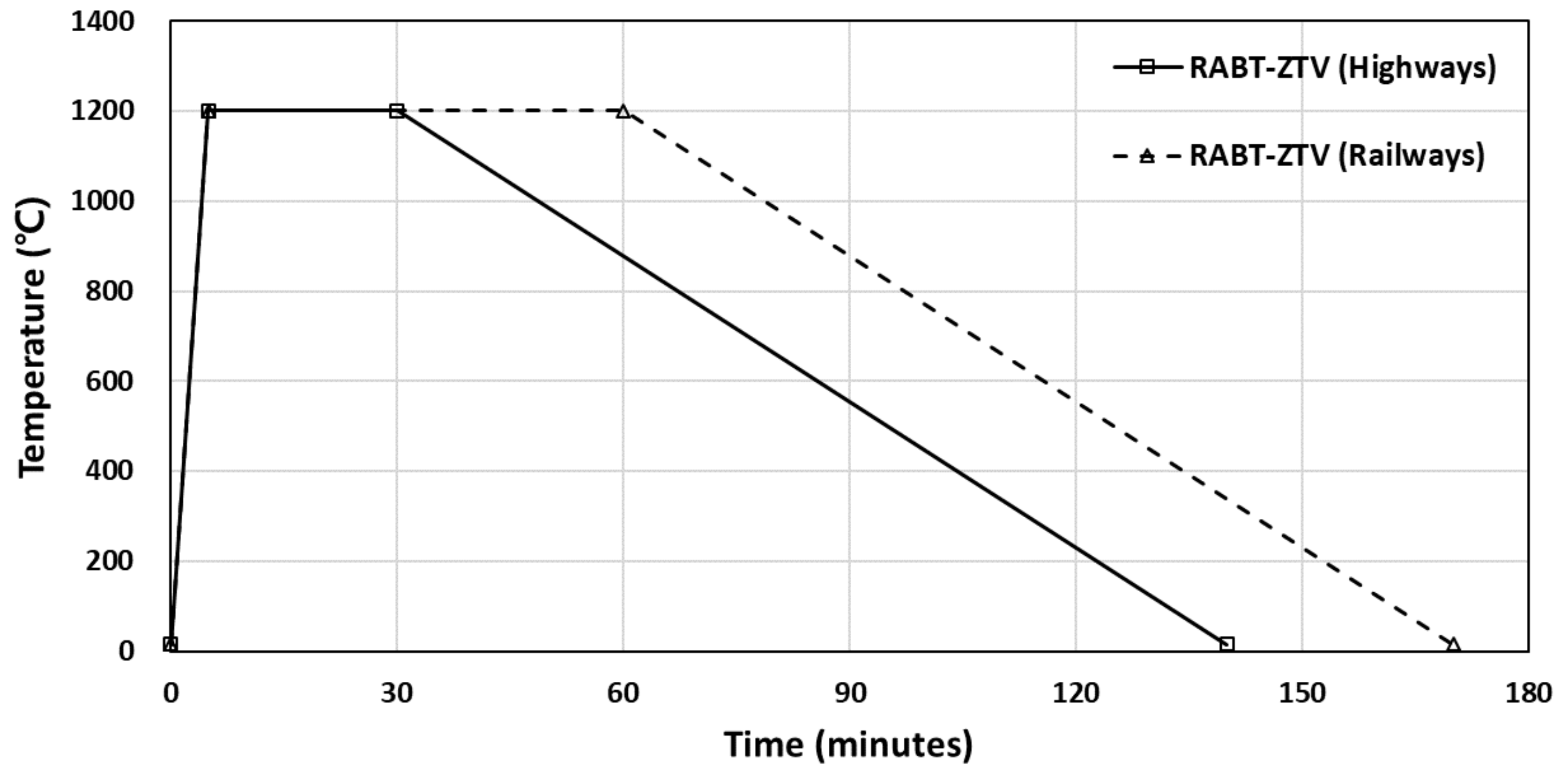
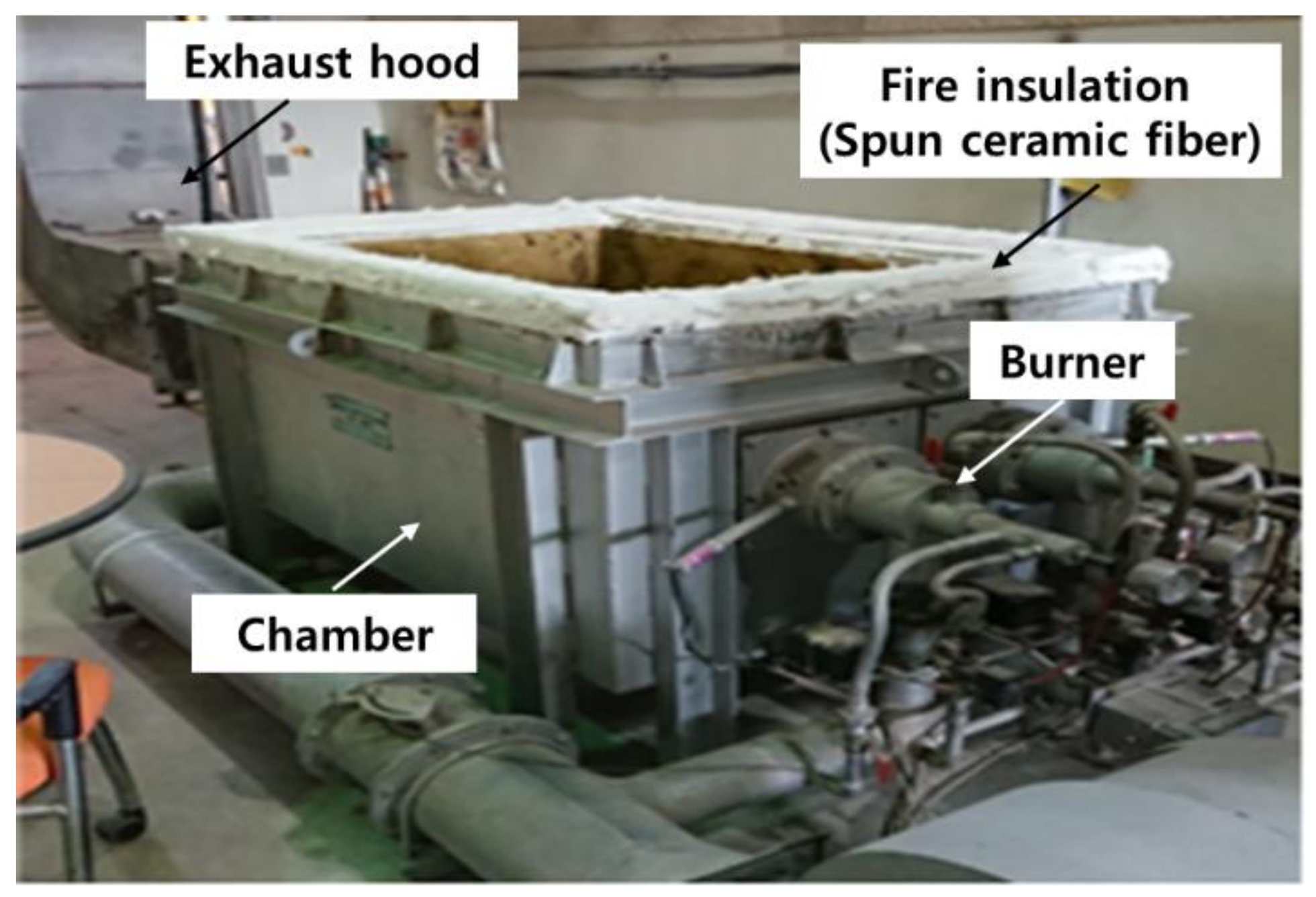


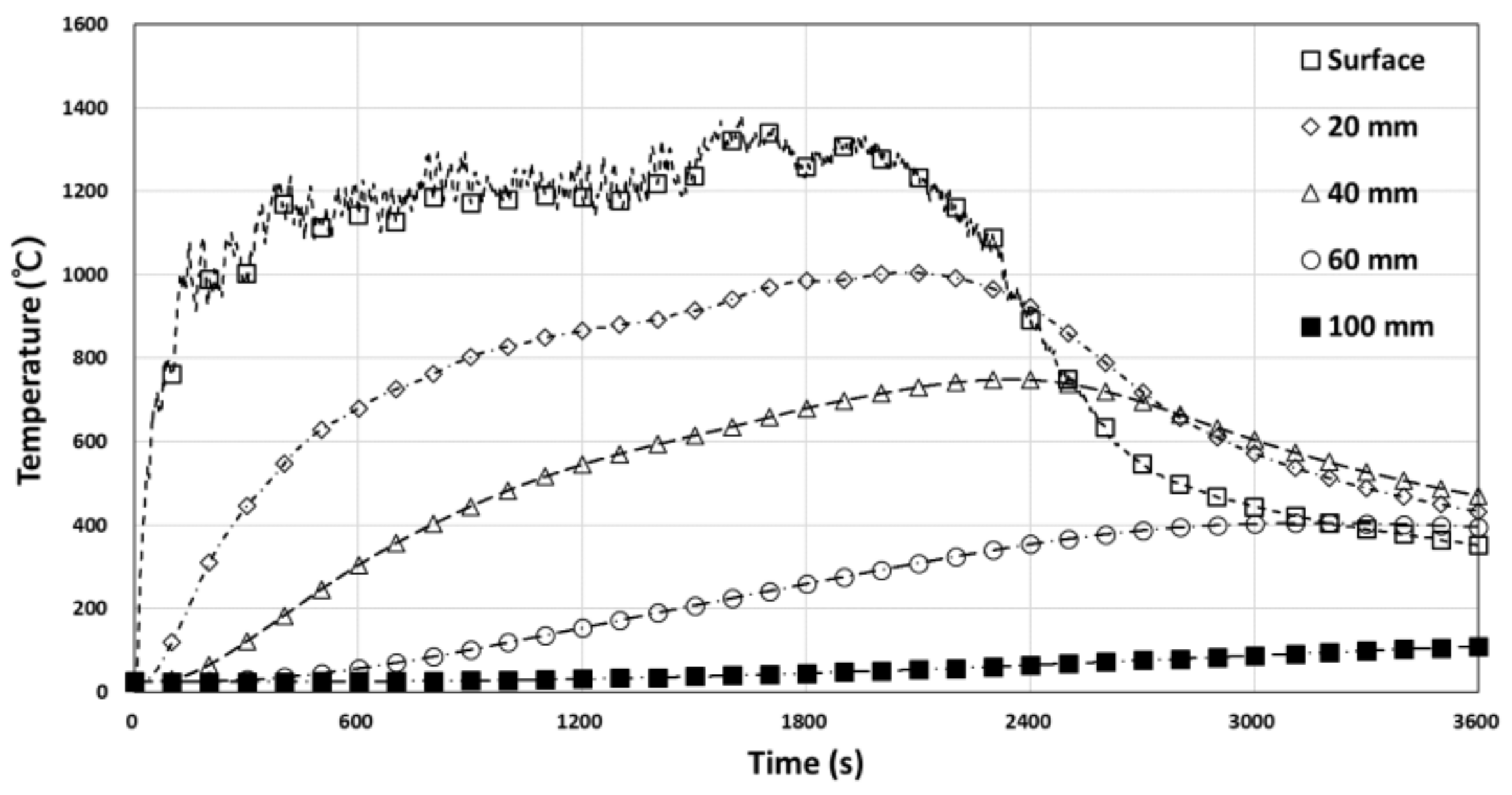
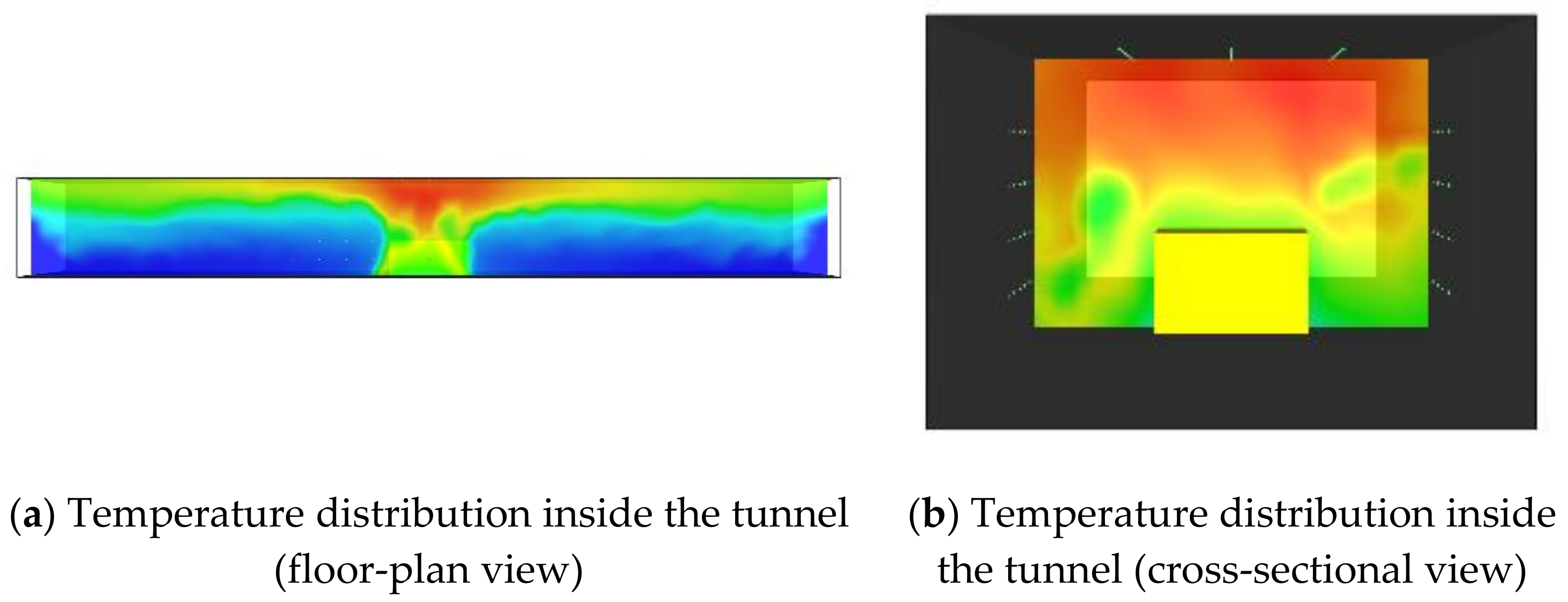

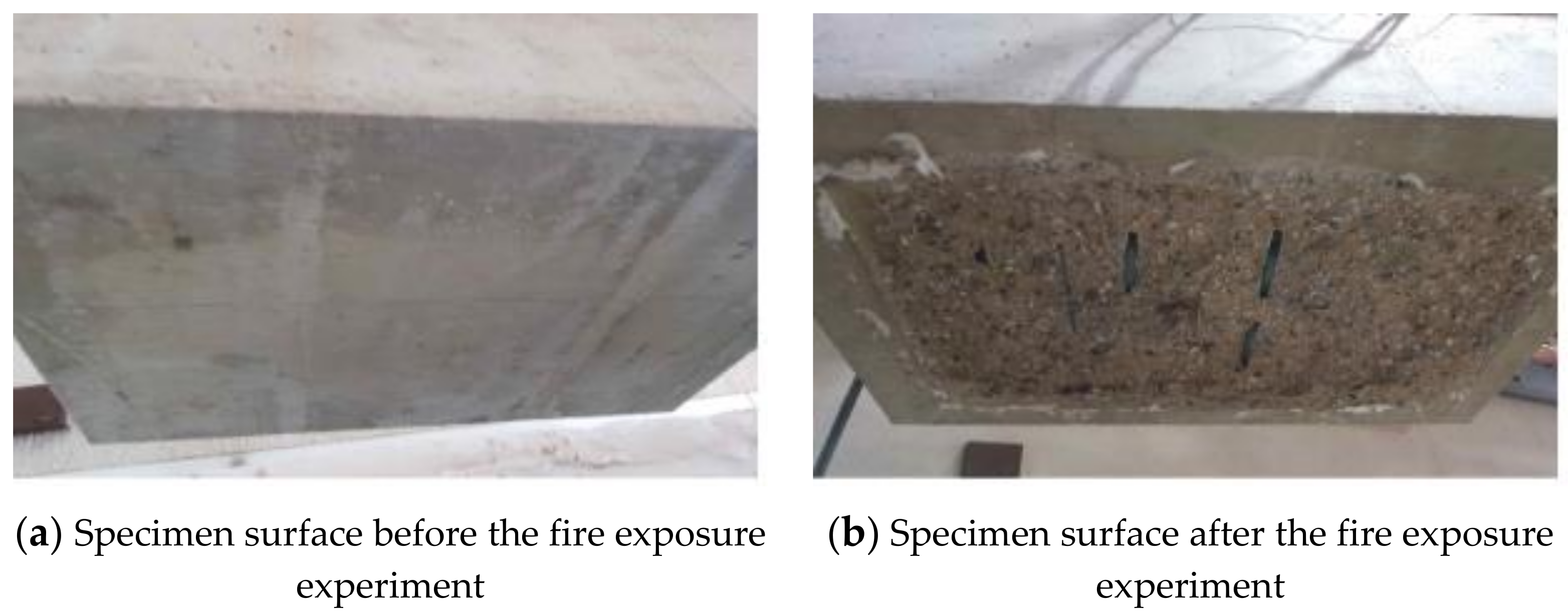
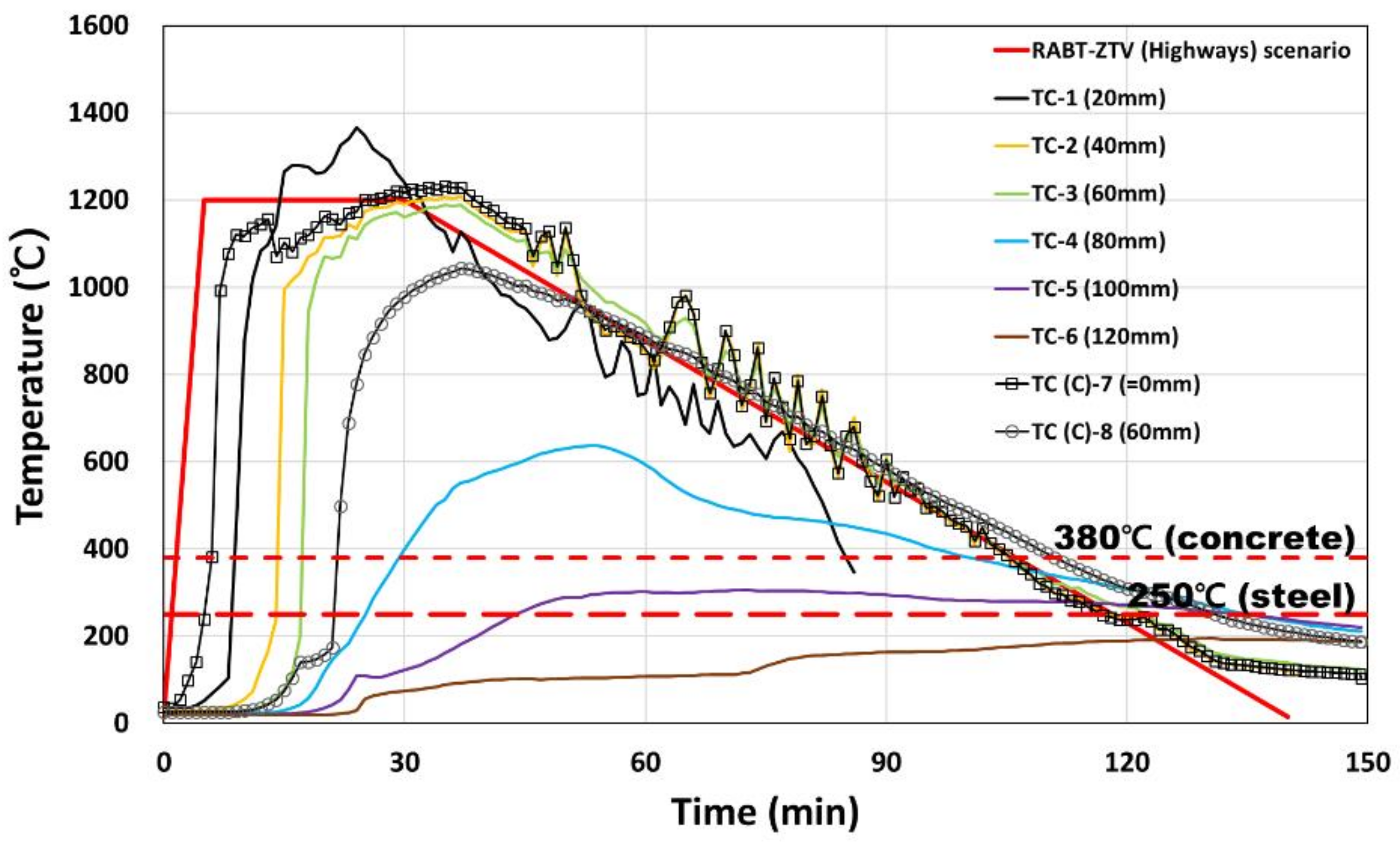

| Parameters | Input Data |
|---|---|
| Space size (m) | 45 × 8 × 5.5 |
| Grid size (m) | 0.5 × 0.5 × 0.5 |
| Conductivity of concrete (W/m·K) | 1.28 |
| Specific heat of concrete (KJ/kg·K) | 0.75 |
| Density of concrete (kg/m3) | 2400 |
| Vehicle location | Middle of the tunnel 27,000 L capacity |
| Combustion material type | Diesel, ethanol, octane, and heptane |
| Simulation time (s) | 3600 |
| Parameters | Diesel | Ethanol | Octane | Heptane |
|---|---|---|---|---|
| Density (kg/m3) | 840 | 787 | 700 | 684 |
| Specific heat (kJ/kg·K) | 1.89 | 2.45 | 2.15 | 2.25 |
| Thermal conductivity (W/m·K) | 0.18 | 0.17 | 0.13 | 0.124 |
| Emissivity | 0.9 | 1.0 | 0.9 | 0.9 |
| Heat of combustion (kJ/kg) | 44,800 | 29,653 | 47,898 | 48,074 |
| Boiling point (°C) | 250 | 76 | 125 | 98.5 |
| Parameters | Input Data |
|---|---|
| Space size (m) | 45 × 8 × 5.5 |
| Grid size (m) | 0.25 × 0.25 × 0.25 |
| Conductivity of concrete (W/m·K) | 1.28 |
| Specific heat of concrete (KJ/kg·K) | 0.75 |
| Density of concrete (kg/m3) | 2400 |
| Vehicle location | Middle of the tunnel 27,000 L |
| Measured depth of concrete wall (m) | Surface: 20, 40, 60, and 100 |
| Combustion material type | Diesel |
| Simulation time (s) | 3600 |
| Thermocouples | Depth (mm) | ||
|---|---|---|---|
| Left | Centre | Right | |
| - | TC(C)-7 | - | 0 |
| TC(L)-1 | - | TC(R)-1 | 20 |
| TC(L)-2 | - | TC(R)-2 | 40 |
| TC(L)-3 | TC(C)-8 | TC(R)-3 | 60 |
| TC(L)-4 | - | TC(R)-4 | 80 |
| TC(L)-5 | - | TC(R)-5 | 100 |
| TC(L)-6 | - | TC(R)-6 | 120 |
© 2019 by the authors. Licensee MDPI, Basel, Switzerland. This article is an open access article distributed under the terms and conditions of the Creative Commons Attribution (CC BY) license (http://creativecommons.org/licenses/by/4.0/).
Share and Cite
Kim, S.; Shim, J.; Rhee, J.Y.; Jung, D.; Park, C. Temperature Distribution Characteristics of Concrete during Fire Occurrence in a Tunnel. Appl. Sci. 2019, 9, 4740. https://doi.org/10.3390/app9224740
Kim S, Shim J, Rhee JY, Jung D, Park C. Temperature Distribution Characteristics of Concrete during Fire Occurrence in a Tunnel. Applied Sciences. 2019; 9(22):4740. https://doi.org/10.3390/app9224740
Chicago/Turabian StyleKim, Seungwon, Jaewon Shim, Ji Young Rhee, Daegyun Jung, and Cheolwoo Park. 2019. "Temperature Distribution Characteristics of Concrete during Fire Occurrence in a Tunnel" Applied Sciences 9, no. 22: 4740. https://doi.org/10.3390/app9224740





